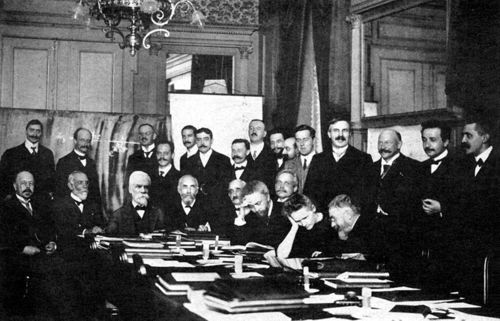JF Ptak Science Books LLC Post 761 Blog Bookstore
By “nothing” I mean Einstein’s relative “nothing” of early
1905 compared to the rest of the hard-working, Ph.D. laden physics field in the
major universities of Germany. And
certainly Einstein was nothing and somewhat nowhere in this regard just prior
to his momentous year of 1905*, scrounging around the fringes of the academic
world, working as a patent examiner, trying to get his doctorate hammered out
and accepted.
[Invited attendees for the 1911
Solvay Conference at the Hotel Metropole. included Seated
(L-R): W. Nernst, M.
Brillouin, E. Solvay, H.
Lorentz, E. Warburg, J. Perrin, W. Wien,
M. Curie,
and H. Poincaré. Standing (L-R): R. Goldschmidt, M. Planck,
H.
Rubens, A. Sommerfeld, F. Lindemann, M. de Broglie, M.
Knudsen, F. Hasenöhrl, G. Hostelet, E. Herzen, J.H. Jeans, E.
Rutherford, H. Kamerlingh Onnes, A.
Einstein and P. Langevin.]
Einstein is evidently not moved by the proceedings, writing that he had heard “nothing new”, at least at the formal meetings. The conference was for a full week,but since everyone was staying at the same hotel (which would’ve been a pretty potent address for that week) I assume that a lot was discussed in private—evidently Einstein was extremely quiet during the official proceedings, but became animated in private, post-conference conversations.
My point for this post, really, is quite simple—the extraordinary academic rise in Einstein’s fortunes during the 1909-1911 period, captured in this famous photo. Einstein was a bona fide powerhouse (the powerhouse) by this point, what with his revolutionary 1905 papers, plus the blockbusters of 1906, 1908 and 1911, and still yet getting stronger. (Incidentally, I always wondered about Einstein’s hand position in photos like this, showing one hand seemingly forming a neat zero with index and thumb. Actually, that hand is in the same position for this photo and for the other Solvay Conferences that Einstein attended (the 2nd, 5th and 6th)—the mystery for me was solved by my friend Dr. Raymond Cooper, who pointed out to me that it was just Einstein holding his pipe.
*It really is hard to overstate the importance of Einstein’s efforts in this year. Really.
The four papers in volume 17 of the Annalen der Physik:
-Über einen die Erzeugung und Verwandlung des Lichtes betreffenden heuristishen Gesichtspunkt, (“On a Heuristic Point of View concerning the Production and Transformation of Light.”) being the photoelectricity/quantum of light paper, received March 18 and published June 9.
-Die von der molekularkinetischen Theorie der Wärme geforderte Bewegung von
in ruhenden Flüssigkeiten suspendierten Teilchen, (“On the Movement of
Small Particles Suspended in Stationary Liquids Required by the Molecular-Kinetic
Theory of Heat”), being the Brownian
Motion of particles/atomic theory paper, received May 11, published
July 18.
-Elektrodynamic bewegter Körper, (“On the Electrodynamics of Moving
Bodies”), being the special relativity theory paper,. received
June 30 and published 26 September.
-Ist die Trägheit eines Körpers von seinem Energieeinhalt abhängig? (“Does the Inertia of a Body Depend upon Its Energy Content?”), being the mass-energy equivalence paper (and the kernel of E=mc²), received September 27 and published November 21.
A List of the Solvay Conferences (the number, followed by its year, a translation of the title of the conference, and the conference chair):
1. 1911 La théorie du
rayonnement et les quanta The theory of
radiation and quanta Hendrik Lorentz (Leiden
2. 1913 La structure
de la matière The structure of matter.
Hendrik Lorentz (Leiden
3. 1921 Atomes et
électrons Atoms and electrons. Hendrik
Lorentz (Leiden
4. 1924 Conductibilité
électrique des métaux et problèmes connexes Electric
conductivity of metals and related problems. Hendrik Lorentz (Leiden
5. 1927 Electrons et
photons Electrons and photons. Hendrik
Lorentz (Leiden
6. 1930 Le magnétisme
Magnetism Paul Langevin (Paris
7. 1933 Structure et
propriétés des noyaux atomiques Structure
& properties of the atomic nucleus. Paul Langevin (Paris
8. 1948 Les
particules élémentaires Elementary
particles Sir Lawrence Bragg (Cambridge
9. 1951 L'état solide
The solid state. particles Sir
Lawrence Bragg (Cambridge
10. 1954 Les
électrons dans les métaux Electrons in
metals particles Sir Lawrence Bragg
(Cambridge
11. 1958 La structure
et l'évolution de l'univers The structure
and evolution of the universe particles Sir Lawrence Bragg (Cambridge
12. 1961 La théorie
quantique des champs Quantum field theory
particles Sir Lawrence Bragg (Cambridge
13. 1964 The
Structure and Evolution of Galaxies J. R. Oppenheimer (Princeton
14. 1967 Fundamental
Problems in Elementary Particle Physics R. Møller (Copenhagen
16. 1973 Astrophysics
and Gravitation. Edoardo Amaldi (Rome
17. 1978 Order and Fluctuations in Equilibrium and Nonequilibrium Statistical Mechanics Léon van Hove (CERN)
18. 1982 Higher Energy Physics. Léon van Hove (CERN)
19. 1987 Surface Science F.W. de Wette (Austin)
20. 1991 Quantum
Optics Paul Mandel (Brussels
21. 1998 Dynamical
Systems and Irreversibility Ioannis Antoniou (Brussels
22. 2001 The Physics
of Communication. Ioannis Antoniou (Brussels
23. 2005 The Quantum
Structure of Space and Time David Gross (Santa
Barbara
24. 2008 Quantum Theory of Condensed Matter Bertrand Halperin (Harvard)




Comments